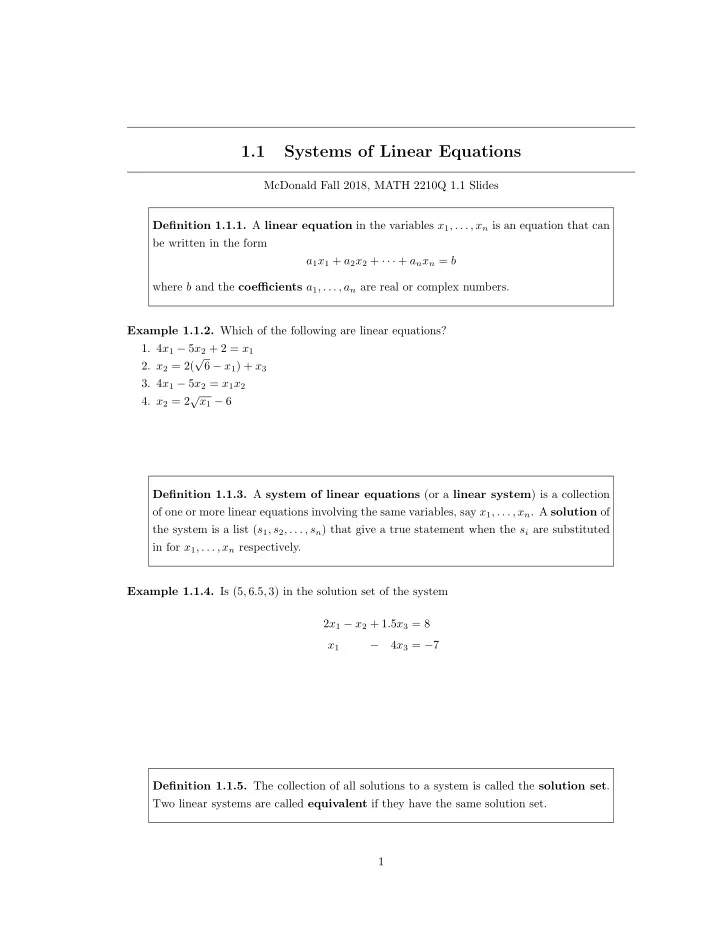

1.1 Systems of Linear Equations McDonald Fall 2018, MATH 2210Q 1.1 Slides Definition 1.1.1. A linear equation in the variables x 1 , . . . , x n is an equation that can be written in the form a 1 x 1 + a 2 x 2 + · · · + a n x n = b where b and the coefficients a 1 , . . . , a n are real or complex numbers. Example 1.1.2. Which of the following are linear equations? 1. 4 x 1 − 5 x 2 + 2 = x 1 √ 2. x 2 = 2( 6 − x 1 ) + x 3 3. 4 x 1 − 5 x 2 = x 1 x 2 4. x 2 = 2 √ x 1 − 6 Definition 1.1.3. A system of linear equations (or a linear system ) is a collection of one or more linear equations involving the same variables, say x 1 , . . . , x n . A solution of the system is a list ( s 1 , s 2 , . . . , s n ) that give a true statement when the s i are substituted in for x 1 , . . . , x n respectively. Example 1.1.4. Is (5 , 6 . 5 , 3) in the solution set of the system 2 x 1 − x 2 + 1 . 5 x 3 = 8 4 x 3 = − 7 x 1 − Definition 1.1.5. The collection of all solutions to a system is called the solution set . Two linear systems are called equivalent if they have the same solution set. 1
Proposition 1.1.6. A system of linear equations has 1. no solution, or 2. exactly one solution, or 3. infinitely many solutions. A system is called consistent if it has either one or infinitely many solutions, and inconsistent if it has no solution. Remark 1.1.7. You already know how to find the solution set to a system of two linear equations in two unknowns! Just find the intersection of the two lines! Example 1.1.8. What are the solution sets of the following systems? Are they consistent? (a) x 1 − 2 x 2 = − 1 (b) x 1 − 2 x 2 = − 1 (c) x 1 − 2 x 2 = − 1 − x 1 + 3 x 2 = 3 − x 1 + 2 x 2 = 3 2 x 1 − 4 x 2 = − 2 Remark 1.1.9. The basic strategy for solving a system is to replace it with an equivalent system that’s easier to solve. We can do this by replacing one equation by the sum of itself with the multiple of another equation, interchanging equations, or multiplying an equation by a nonzero constant. 2
Definition 1.1.10. The essential information in a linear system can be recorded into a rectangular array called a matrix . For example, given the system x 1 − 2 x 2 + x 3 = 0 2 x 2 − 8 x 3 = 8 5 x 1 − 5 x 3 = 10 with the coefficients of each variable aligned in columns, the matrix 1 − 2 1 0 2 − 8 5 0 − 5 is called the coefficient matrix of the system, and 1 − 2 1 0 0 2 − 8 8 5 0 − 5 10 is called the augmented matrix of the system. The size of a matrix tells us how many rows and columns it has. An m × n matrix has m rows and n columns. Remark 1.1.11. Matrices will make our lives much easier when solving systems of linear equations! Example 1.1.12. Solve the system in the definition. 3
4
Definition 1.1.13 (Elementary Row Operations) . 1. (Replacement) replace one row by the sum of itself and a multiple of another row. 2. (Interchanging) Interchange two rows. 3. (Scaling) Multiply all entries in a row by a nonzero constant. Two matrices are called row equivalent if there is a sequence of elementary row operations that transforms one matrix into the other. Remark 1.1.14. If the augmented matrices of two linear systems are row equivalent, then the two systems have the same solution set. Remark 1.1.15. We will be interested in two fundamental questions about linear systems: 1. Is the system consistent? 2. If a system is consistent, is the solution unique? Example 1.1.16. Determine if the following system is consistent: x 1 − 2 x 2 + x 3 = 0 2 x 2 − 8 x 3 = 8 5 x 1 − 5 x 3 = 10 5
Example 1.1.17. Determine if the following system is consistent: x 2 − 4 x 3 = 8 2 x 1 − 3 x 2 + 2 x 3 = 1 4 x 1 − 8 x 2 + 12 x 3 = 1 6
Recommend
More recommend